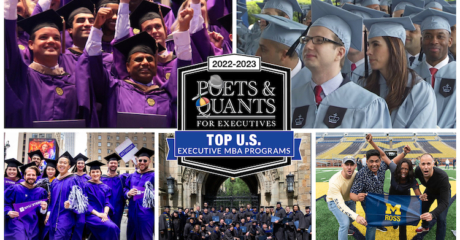Application Deadlines:
Round 2: January, 30th, 2018
Round 3: March 27, 2018
Round 4: May 29th, 2018
The Texas Executive MBA program is an unqualified bargain among the top ten schools. Even after an increase in tuition this past year, its EMBA program is still the only one among the top ranked ten schools with a price tag under six figures. The two-year program, consisting of four consecutive academic semesters and 42 credit hours of coursework. Each year commences with a week-long executive seminar to help prepare students for the upcoming year and concludes with a week-long seminar to apply what has been learned.
Unlike many EMBA programs that tend to draw the largest number of students from financial services and consulting, Texas’ attracts a very high percentage of managers and executives from the technology field. Some 42% of the latest entering class, for example, hails from the high-tech industry. It’s a diverse and impressive group: some 39% of the students already have advanced degrees and 5% have the title president, CEO or Chairman.
The goals of the Texas EMBA are to encourage and support students’ development in the following areas: top management perspective; economic, social, and political forces driving changes in international and domestic markets; competence in key functional areas of business; command of quantitative and qualitative tools; and capabilities in analyzing and redesigning organizations. In addition to the core coursework, participants complete six elective hours tailored to their specific areas of interest.
Classes, which vary in approach from lectures to discussions to case studies, group projects, and experiential learning, are scheduled on alternate weekends, meeting on both Friday and Saturday from 8:00am-5:30pm at the AT&T Executive Conference Center at The University of Texas at Austin.
Student Perspectives:
EMBA Road Warrior: Stephanie Carlton
Final Application Deadline: May 17
Latest Up-to-Date Executive MBA Rankings:
2012 Poets&Quants: 9
2011 U.S. News & World Report: 18
2010 The Wall Street Journal: 12
Rankings Analysis: Texas’ premier EMBA program maintained its rank of ninth in our composite 2012 survey, though like most schools, there were mostly inconsequential ups and downs in the major rankings.
The biggest hit was U.S. News’ four-place drop to 18th from 14th in 2010. But that was more than made up for by a seven-place gain in The Financial Times’ survey which ranked the school’s EMBA program 45th in the world, up from 52nd in 2010. McCombs also gained in the biennial BusinessWeek ranking, which measures programs by graduate satisfaction and a reputation poll among EMBA directors. BusienssWeek, which had relegated the Texas program to “second-tier” status in 2009, promoted it to a rank of 23rd in 2011.
As one Class of 2011 grad told BusinessWeek, “I’m very happy with my investment of time and money in this program. Professors are happy to continue a mentoring relationship even after the program and my fellow students were top notch.”
Application Fee: $125
2012 Tuition & Fees: $85,000, up from $75,000 (resident) in 2011
2012 Tuition & Fees: $85,000, up from $80,169 (non-resident) in 2011
Average Months of Work Experience: 166
GMAT Required: Yes
Average GMAT Score: 638
GMAT Range (mid-80%): 560-726
Acceptance Rate: 74%
Enrollment: 126
International: 25%
Female: 19%
African-American: 4%
Asian: 6%
Hispanic/Latino: 11%
Mean Age: 37
Classes Meet: Alternate weekends
Length of program: 2 years
Students From These Sectors:
Consulting: 0%
Consumer Products: 2%
Financial Services: 8%
Government: 3%
Manufacturing: 2%
Media/Entertainment: 3%
Non-Profit: 2%
Petroleum/Energy: 6%
Pharmaceutical/Biotechnology/Health Care: 11%
Real Estate: 2%
Technology: 42%
Other: 20%









